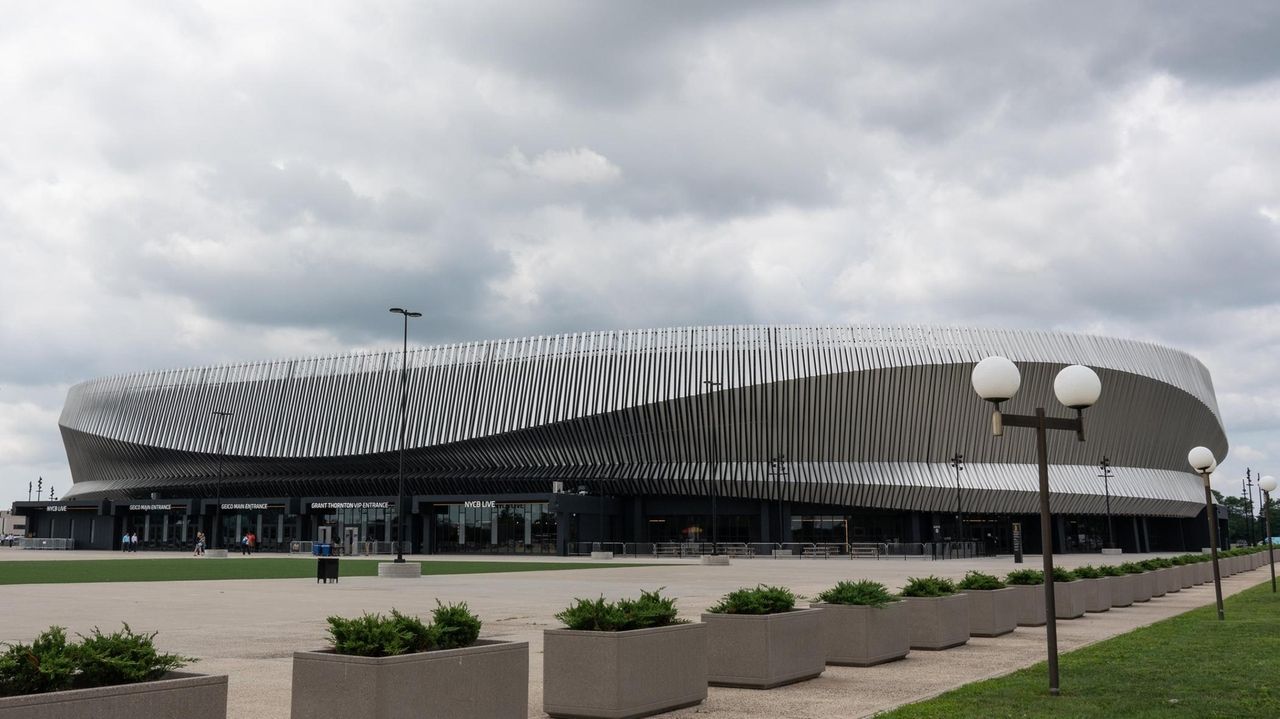Las Vegas Sands this week secured nearly all the land-use approvals for a $7.6 billion casino-resort at the Nassau Coliseum that company executives lobbied for years to build — two months after they’ve decided not to build it.
Sands officials in April announced they would not pursue a state gaming license and scrapped the plan they pitched to the county in January 2023. After two years of legal battles, packed public hearings and a more than 28,000-page environmental study, the Nevada-based firm cleared major hurdles in getting bipartisan support in the county legislature on Monday for its final environmental impact statement and then on Tuesday unanimous approval in the Town of Hempstead to change the decades-old zoning code. The 72-acre Coliseum site and the nearby Long Island Marriott, however, have been combined, designated the Mitchel Field Integrated Resort District.
Whereas past development proposals were mired in local politics and zoning fights, this time it’s reversed: The approvals are in place, but there is no project.
Commercial real estate brokers, Sands executives and labor leaders say that while the casino-resort plan has been shelved, it paved the way to future development by gaining broad political support, presenting ideas to reduce traffic and successfully rezoning the county-owned property. These moves will help fast-track the process for a future developer while potentially raising the value of Sands’ lease on the property, they said.
Brian G. Schwagerl, who teaches a class on zoning and land use at the Schack Institute of Real Estate at New York University, said one of the biggest obstacles any developer faces is zoning. Up until recently, the Coliseum site was renowned for having had strict limits on what can operate there.
“Think of how long it takes to get developers to get approvals for zoning. This is unprecedented. The location is a prime location and this presents a fresh start,” Schwagerl said.
Schwagerl, a native of Rockville Centre, agreed with others who say community opposition, local politics and the Town of Hempstead’s zoning laws — governing building height and what the land can be used for — deterred development there for decades. Like the Lighthouse Project from years ago, “large, ambitious proposals,” even if they do not get built, can kick-start a conversation and “set the standard” for what the surrounding community will accept, he said.
The new resort district allows for buildings as high as 280 feet, or the same height as Nassau University Medical Center in East Meadow. It also loosens restrictions on the type of activity allowed on the Coliseum property to include gambling. The Lighthouse Project, pitched about two decades ago by late billionaire Charles Wang, then-owner of the Islanders hockey team, failed to gain Hempstead Town approvals to build high-rises. He eventually moved the team from its original home at the Coliseum to the Barclays Center in Brooklyn.
“Modernizing the existing code clears a pathway to new ideas moving forward,” Schwagerl said. “The idea that there’s a resort district now means that it can take on many more uses.”
Nassau County Executive Bruce Blakeman said last week that with a plan for a casino scuttled, the county would pivot to “Plan B.” This week, in an emailed statement to Newsday, Blakeman said: “As a condition for a lease extension, the Sands will develop the site based on plans approved by the county in conformity with town zoning.” He and a spokesman did not answer questions seeking details about Plan B or Sands’ development obligations.
According to Sands’ lease, the company’s only obligation is to operate the arena and parking lot. Sands holds a 42-year lease that doesn’t legally obligate the company to build an alternative project now that the original plan for a Vegas-style casino is dead.
Michael Levoff, senior vice president at Sands, said the company is committed to facilitating an alternative project at the site and is in discussions with several different developers. He declined to name the developers with whom Sands is in talks.
“While the proposal for an integrated resort is not proceeding, Sands has drastically shortened the time necessary to progress an alternative development by completing the environmental review process and having the site rezoned for uses that make both economic sense, but also fit with the County’s and community’s shared vision for the site,” Levoff said in a statement to Newsday this week.
Sands executives had been seeking a 99-year lease to build their U.S. flagship resort in Nassau: a casino, two luxury hotel towers, live entertainment venue, convention center, restaurants, shops, public gathering space, a day spa and wellness center. They were vying for one of the three state licenses that would allow traditional, live-dealer table games such as poker and blackjack. Their interest in the Coliseum site was tied to getting the state gambling license, but Sands would have the ability to transfer the environmental approvals to another company.
David Pennetta, executive managing director of the Long Island office of Cushman & Wakefield and strategic officer of the Commercial Industrial Brokers Society of Long Island, noted how time consuming and expensive it is to pursue an environmental review and rezoning “whether you get the required approvals or not.”
“Time is risk, and risk is money — by furthering the entitlements you are reducing the risk. Any partnership or transfer by Sands to a third party, if allowed, would be more valuable to both parties,” Pennetta said.
Labor and business leaders say they are still hoping for an entertainment project that might have some form of gaming at the site. Those representing construction and trades workers say a new project is needed to replace the thousands of permanent and temporary jobs the Sands casino-resort would have brought to Nassau.
Matthew Aracich, president of the Building and Construction Trades Council of Nassau and Suffolk Counties, said “there are discussions that are starting to happen” about what will be built next, but he has not been part of them. “I do not know what the redesign is,” he said.
Ed Blumenfeld, founder and owner of Blumenfeld Development Group, which has bid several times to build on the Coliseum site, agreed with others in saying “zoning is the key to development.”
“To get approvals is Long Island’s nemesis,” said Blumenfeld, noting a heightened not-in-my-backyard mentality. He said the struggle to develop at the Coliseum site is “going on more than two generations.”
“I know firsthand the challenges and opportunities there,” he said. “But I believe that if prior administrations had gone forward with other submissions — one of which was ours — they would be producing revenue today.”
Las Vegas Sands this week secured nearly all the land-use approvals for a $7.6 billion casino-resort at the Nassau Coliseum that company executives lobbied for years to build — two months after they’ve decided not to build it.
Sands officials in April announced they would not pursue a state gaming license and scrapped the plan they pitched to the county in January 2023. After two years of legal battles, packed public hearings and a more than 28,000-page environmental study, the Nevada-based firm cleared major hurdles in getting bipartisan support in the county legislature on Monday for its final environmental impact statement and then on Tuesday unanimous approval in the Town of Hempstead to change the decades-old zoning code. The 72-acre Coliseum site and the nearby Long Island Marriott, however, have been combined, designated the Mitchel Field Integrated Resort District.
Whereas past development proposals were mired in local politics and zoning fights, this time it’s reversed: The approvals are in place, but there is no project.
Commercial real estate brokers, Sands executives and labor leaders say that while the casino-resort plan has been shelved, it paved the way to future development by gaining broad political support, presenting ideas to reduce traffic and successfully rezoning the county-owned property. These moves will help fast-track the process for a future developer while potentially raising the value of Sands’ lease on the property, they said.
‘A fresh start’
Brian G. Schwagerl, who teaches a class on zoning and land use at the Schack Institute of Real Estate at New York University, said one of the biggest obstacles any developer faces is zoning. Up until recently, the Coliseum site was renowned for having had strict limits on what can operate there.
“Think of how long it takes to get developers to get approvals for zoning. This is unprecedented. The location is a prime location and this presents a fresh start,” Schwagerl said.
Schwagerl, a native of Rockville Centre, agreed with others who say community opposition, local politics and the Town of Hempstead’s zoning laws — governing building height and what the land can be used for — deterred development there for decades. Like the Lighthouse Project from years ago, “large, ambitious proposals,” even if they do not get built, can kick-start a conversation and “set the standard” for what the surrounding community will accept, he said.
The new resort district allows for buildings as high as 280 feet, or the same height as Nassau University Medical Center in East Meadow. It also loosens restrictions on the type of activity allowed on the Coliseum property to include gambling. The Lighthouse Project, pitched about two decades ago by late billionaire Charles Wang, then-owner of the Islanders hockey team, failed to gain Hempstead Town approvals to build high-rises. He eventually moved the team from its original home at the Coliseum to the Barclays Center in Brooklyn.
“Modernizing the existing code clears a pathway to new ideas moving forward,” Schwagerl said. “The idea that there’s a resort district now means that it can take on many more uses.”
‘Plan B’
Nassau County Executive Bruce Blakeman said last week that with a plan for a casino scuttled, the county would pivot to “Plan B.” This week, in an emailed statement to Newsday, Blakeman said: “As a condition for a lease extension, the Sands will develop the site based on plans approved by the county in conformity with town zoning.” He and a spokesman did not answer questions seeking details about Plan B or Sands’ development obligations.
According to Sands’ lease, the company’s only obligation is to operate the arena and parking lot. Sands holds a 42-year lease that doesn’t legally obligate the company to build an alternative project now that the original plan for a Vegas-style casino is dead.
Michael Levoff, senior vice president at Sands, said the company is committed to facilitating an alternative project at the site and is in discussions with several different developers. He declined to name the developers with whom Sands is in talks.
“While the proposal for an integrated resort is not proceeding, Sands has drastically shortened the time necessary to progress an alternative development by completing the environmental review process and having the site rezoned for uses that make both economic sense, but also fit with the County’s and community’s shared vision for the site,” Levoff said in a statement to Newsday this week.
Sands executives had been seeking a 99-year lease to build their U.S. flagship resort in Nassau: a casino, two luxury hotel towers, live entertainment venue, convention center, restaurants, shops, public gathering space, a day spa and wellness center. They were vying for one of the three state licenses that would allow traditional, live-dealer table games such as poker and blackjack. Their interest in the Coliseum site was tied to getting the state gambling license, but Sands would have the ability to transfer the environmental approvals to another company.
David Pennetta, executive managing director of the Long Island office of Cushman & Wakefield and strategic officer of the Commercial Industrial Brokers Society of Long Island, noted how time consuming and expensive it is to pursue an environmental review and rezoning “whether you get the required approvals or not.”
“Time is risk, and risk is money — by furthering the entitlements you are reducing the risk. Any partnership or transfer by Sands to a third party, if allowed, would be more valuable to both parties,” Pennetta said.
Looking ahead
Labor and business leaders say they are still hoping for an entertainment project that might have some form of gaming at the site. Those representing construction and trades workers say a new project is needed to replace the thousands of permanent and temporary jobs the Sands casino-resort would have brought to Nassau.
Matthew Aracich, president of the Building and Construction Trades Council of Nassau and Suffolk Counties, said “there are discussions that are starting to happen” about what will be built next, but he has not been part of them. “I do not know what the redesign is,” he said.
Ed Blumenfeld, founder and owner of Blumenfeld Development Group, which has bid several times to build on the Coliseum site, agreed with others in saying “zoning is the key to development.”
“To get approvals is Long Island’s nemesis,” said Blumenfeld, noting a heightened not-in-my-backyard mentality. He said the struggle to develop at the Coliseum site is “going on more than two generations.”
“I know firsthand the challenges and opportunities there,” he said. “But I believe that if prior administrations had gone forward with other submissions — one of which was ours — they would be producing revenue today.”






